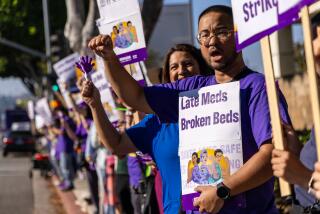Today’s School Nurse Is No ‘Band-Aid Queen’ : Health: A pilot program sends them to eight elementary schools each week to screen for everything from malnourishment to war-related stress.
- Share via
Virginia Hayes sits in a sparsely decorated office, applying equal amounts of Band-Aids and TLC to the knee-scraped children who come through her door. On a busy day, one or two feverish children may rest on a cot until their parents arrive to take them home.
A typical picture of today’s school nurse? Not exactly.
“People have the stereotyped image about school nurses being like a Band-Aid queen. But when you’re dealing with a district like ours, where children come from all over the world and often travel great distances each day to go to school, it’s the farthest thing from the truth,” said Hayes, director of nursing services for the Los Angeles Unified School District.
“We’re talking about everything from malnourishment, severe dental problems and lack of immunizations, to post-traumatic stress syndrome in children from war-torn countries,” she said. “In the past, those haven’t exactly been your typical school nurse health concerns.”
Last year, at the urging of school officials and community groups, the school district instituted a pilot program at eight Los Angeles and San Fernando Valley elementary schools to meet those student health needs. Under the Capacity Adjustment Program (CAP), school nurses were assigned to different schools each week to screen students for health care and other support services.
Children from low-income families were referred to school-affiliated clinics, where dental, vision and other health services are provided on a sliding-scale basis.
Since its inception, the program has been expanded to address the needs of about 35,000 students who travel by bus to school, according to CAP Resource Coordinator Modesta Bassity. CAP now includes 14 traveling nurses--11 of whom serve 60 schools in the San Fernando Valley.
“We can catch problems a lot quicker now that interfere with learning,” said Jayne Lawson, a former pediatric nurse who travels to various schools in the Valley. “A lot of times, the parents haven’t known what to do or where to go.”
Providing information to parents, Lawson said, is often an essential part of the program. Lawson recalled one recent health screening of an 8-year-old Latino girl who lives in Los Angeles and attends an elementary school in the Valley. The girl’s teacher had sent the child to see Lawson after noticing that she was sleepy in class and had difficulty paying attention.
Although Lawson noted immediately that the girl was underweight for her age, further checking revealed that she received breakfast each day at school.
“It wasn’t until I looked at her teeth that I understood the problem,” Lawson said. “She had such massive cavities that her teeth had eroded away to little nubs. It was horrible. Eating was painful for her.”
Lawson contacted the girl’s parents and told them about low-cost dental services that were available through the school district. Later, she visited the parents at their home to discuss the importance of proper nutrition and hygiene.
“The mother was very concerned, but she hadn’t had any idea about what foods were good for her child,” she said. “She had been giving her foods that were very high in sugar and didn’t know very much about protein.”
Children are also screened by traveling nurses for vision problems that, nurses say, often have gone undetected or untreated. Through two district-affiliated clinics in the Valley, children who qualify can receive low-cost glasses.
“For a lot of poor families, dental and vision problems are low priorities,” said Janis Lake, who works as a traveling school nurse in Granada Hills. “A lot of the children literally cannot see, but the parents haven’t known that these services were available.”
Cultural and language differences can exacerbate health problems. The Los Angeles Unified School District has seven major ethnic groups and as many as 90 different languages spoken in its schools.
Patricia Hughes, another traveling school nurse and past president of the Council of School Nurses, said she sees many cases that require contacting parents and providing nutritional information. “We send letters home with the children, but many times the parents can’t read. That’s when we call. When you have children from Cambodia and Vietnam, where they lived on rice and water for a long time, the parents need to realize how the children have been physically affected.”
There also have been cases in which a child complains of an ailment, such as a stomachache or headache, for which no physical cause can be found. In such cases, Hayes said, the nurses often work as detectives, looking for something in the child’s past that will give them a clue to the problem.
“Some children show signs of post-traumatic stress from war, such as with children from El Salvador,” Hayes said. “They’ve seen a lot of death and carry it around with them. We see the same thing in a lot of children from Los Angeles who have had family members killed by gangs,” she said. “Sometimes you need to talk to a child to understand the source.”
For Lawson, who formerly worked as a pediatric nurse, the satisfaction she gets from her job far outweighs the occasional expression she sees when she tells people what she does for a living.
“Telling people you are a school nurse can kind of be a conversation stopper, because they sometimes have that look of, ‘Big deal.’ But it is a big deal,” she said. “We’re reaching a lot of children, and we’re making a big difference in their lives in what often are little ways.”
Lawson smiled. “Not everyone can say that.”
More to Read
Sign up for Essential California
The most important California stories and recommendations in your inbox every morning.
You may occasionally receive promotional content from the Los Angeles Times.













